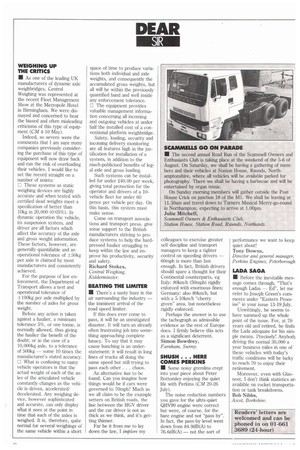WEIGHING UP ME CRITICS
Page 22

If you've noticed an error in this article please click here to report it so we can fix it.
• As one of the leading UK manufacturers of dynamic axle weighbridges, Central Weighing was represented at the recent Fleet Management Show at the Metropole Hotel in Birmingham. We were dismayed and concerned to hear the biased and often misleading criticisms of this type of equipment (CM 4-10 May).
Indeed, so severe were the comments that I am sure many companies previously considering the purchase of this type of equipment will now draw back and run the risk of overloading their vehicles. I would like to set the record straight on a number of Doints:
D These systems as static weighing devices are highly accurate and when tested with certified dead weights meet a specification of better than 10kg in 20,000 (0.05%). In dynamic operation the vehicle, its suspension system, and driver are all factors which affect the accuracy of the axle and gross weight information. These factors, however, are generally quantifiable and an operational tolerance of ±50kg per axle is claimed by most manufacturers and consistently achieved.
For the purpose of law enforcement, the Department of Transport allows a test and operational tolerance of ±100kg per axle multiplied by the number of axles for gross weight.
Before any action is taken against a haulier, a minimum tolerance 5%, or one tonne, is normally allowed, thus giving the haulier the benefit of the doubt; or in the case of a 10,000kg axle, to a tolerance of 500kg — some 10 times the manufacturer's stated accuracy. ID What is confusing to many vehicle operators is that the actual weight of each of the axles of the articulated vehicle constantly changes as the vehicle is driven, accelerated/ decelerated. Any weighing device, however sophisticated and accurate, can only display What it sees at the point in time that each of the axles is weighed. It is, therefore, quite normal for several weighings of the same vehicle within a short space of time to produce variations both individual and axle weights, and consequently the accumulated gross weights, but all will be within the previously quantified band and well inside any enforcement tolerance.
The equipment provides valuable management information concerning all incoming and outgoing vehicles at under half the installed cost of a conventional platform weighbridge.
Safety, loading, security and incoming delivery monitoring are all features high in the justification for installation of a system, in addition to the much-publicised benefits of legal axle and gross loading.
Such systems can be installed for under £40.00 per week, giving total protection for the operator and drivers of a 10vehicle fleet for under 60 pence per vehicle per day. On this basis, this system must make sense.
Come on transport associations and transport press, give some support to the British manufacturers striving to produce systems to help the hardpressed haulier struggling to keep within the law and improve his productivity, security and safety.
Richard Stokes,
Central Weighing, Kidderminster,




































































































